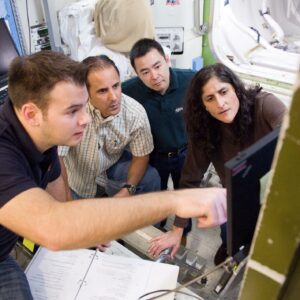
Small Steps, Giant Leaps
Tap into the experiences of NASA’s technical workforce as they develop missions to explore distant worlds—from the Moon to Mars, from Titan to Psyche. Learn how they advance technology to make aviation on Earth faster, quieter and more fuel efficient. Each biweekly episode celebrates program and project managers, engineers, scientists and thought leaders working on multiple fronts to advance aeronautics and space exploration in a bold new era of discovery. New episodes are released bi-weekly on Wednesdays.

EPISODE 120: FUELING INNOVATION: HOW NASA SHARES KNOWLEDGE FOR PROGRESS
In this episode, we sit down with Jim Rostohar, Chief Knowledge Officer for NASA's Johnson Space Center, to explore the vital role of knowledge sharing within the organization. Read More

EPISODE 119: ROCKET PROPULSION TEST PROGRAM
Rocket Propulsion Test Program Manager Christine Powell discusses chemical propulsion testing at NASA’s world-class facilities. Read More

EPISODE 118: CENTER INNOVATION FUND AND EARLY CAREER INITIATIVE
NASA SpaceTech's Michael LaPointe and John Nelson discuss the Center Innovation Fund and Early Career Initiative. Read More

EPISODE 117: NASA TRADE AND TECHNICAL PROFESSIONALS, PART 3
NASA Marshall Space Flight Center Engineering Technicians John Hood, Amy Meekham, and Mark Sloan discuss details of their work on the Imaging X-ray Polarimetry Explorer. Read More

EPISODE 116: NASA TRADE AND TECHNICAL PROFESSIONALS, PART 2
NASA Technicians Scott Bartram, Eric Bentley, Maria Salinas, and Phil Steele discuss their hands-on work on a variety of projects and technologies. Read More

EPISODE 115: NASA TRADE AND TECHNICAL PROFESSIONALS, PART 1
NASA Armstrong Flight Research Center Engineering Technicians Jason Nelson, Kyle Whitfield, and Alex Zamora discuss their essential contributions to NASA missions. Read More

EPISODE 114: LAST STOP BEFORE RETIREMENT
NASA Langley Research Center Retired Chief Scientist Dennis Bushnell discusses highlights of his 60-year NASA career and the future of the agency. Read More

EPISODE 113: OSIRIS-REX SAMPLE RETURN PREPARATION
OSIRIS-REx Mission Systems Engineer Ron Mink discusses preparation for the return of the United States' first asteroid sample from space to Earth. Read More

EPISODE 112: TECHLEAP NIGHTTIME PRECISION LANDING CHALLENGE
NASA TechLeap Nighttime Precision Landing Challenge Manager Greg Peters discusses the lunar landing challenge. Read More





